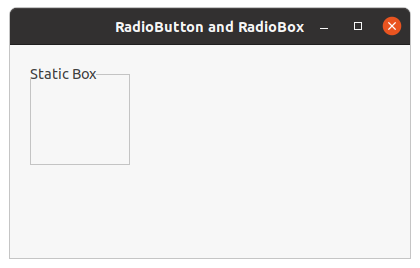wxPython 使用Create()方法创建静态盒子
在这篇文章中,我们将学习wxPython中的静态框。
在这篇文章中,我们将使用两步创建法来创建静态框,为了达到这个目的,我们将使用Create()方法。
语法:wx.StaticBox.Create(parent, id=ID_ANY, label=””, pos=DefaultPosition, size=DefaultSize, style=0, name=StaticBoxNameStr)
参数
| 参数 | 输入类型 | 说明 |
|---|---|---|
| parent | wx.Window | 父窗口。必须不是无。 |
| id | wx.WindowID | 窗口标识符。值wx.ID_ANY表示一个默认值。 |
| label | 字符串 | 要显示在静态框中的文本,空字符串表示没有标签。 |
| pos | wx.Point | 窗口的位置。如果指定了wx.DefaultPosition,那么将选择一个默认位置。 |
| size | wx.Size | 复选框尺寸。如果指定了wx.DefaultSize,那么将选择一个默认的尺寸。 |
| style | 长 | 窗口风格。没有专门针对StaticBox的样式,但通用的ALIGN_LEFT、ALIGN_CENTRE_HORIZONTAL和ALIGN_RIGHT可以在这里使用,以改变使用wxGTK时静态框标签的位置。 |
| name | 字符串 | 窗口名称 |
返回类型:bool
代码示例。
import wx
class FrameUI(wx.Frame):
def __init__(self, parent, title):
super(FrameUI, self).__init__(parent, title = title, size =(300, 200))
# function for in-frame components
self.InitUI()
def InitUI(self):
# parent panel for radio box
pnl = wx.Panel(self)
# initialize static box
self.sb = wx.StaticBox()
# create static box
self.sb.Create(pnl, 2, label ="Static Box", pos =(20, 20), size =(100, 100))
# set frame in centre
self.Centre()
# set size of frame
self.SetSize((400, 250))
# show output frame
self.Show(True)
# wx App instance
ex = wx.App()
# Example instance
FrameUI(None, 'RadioButton and RadioBox')
ex.MainLoop()
输出窗口:

 极客教程
极客教程